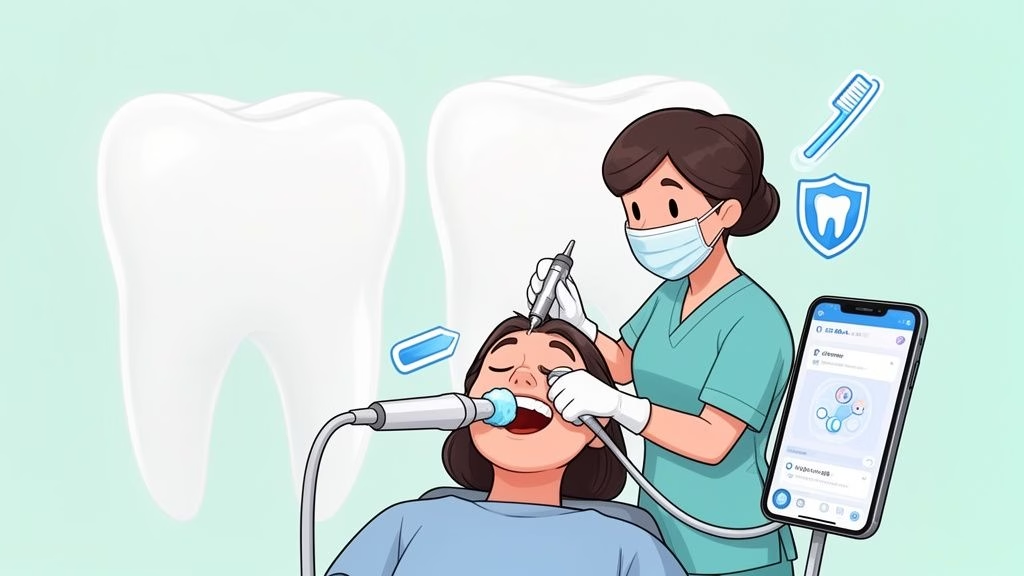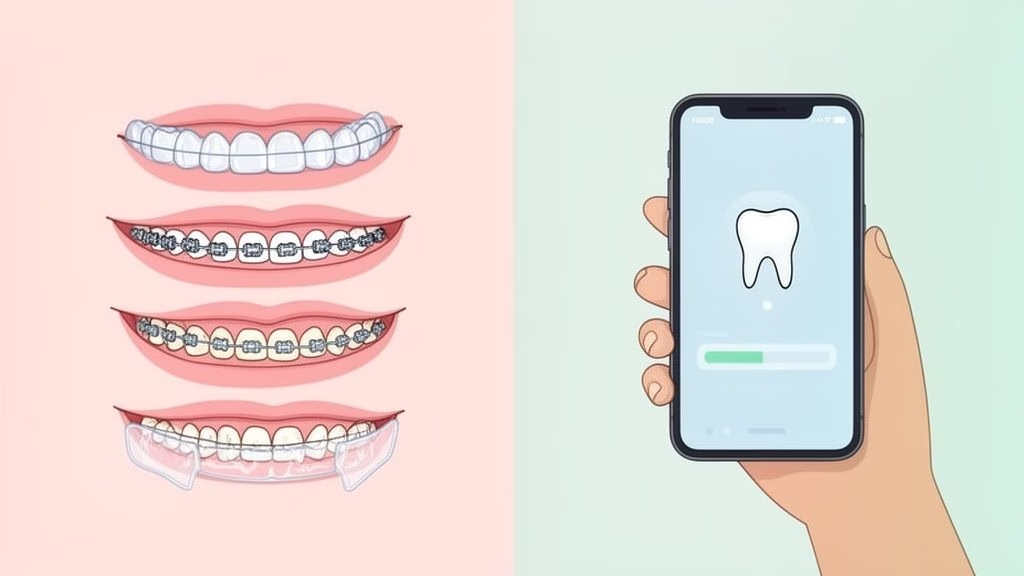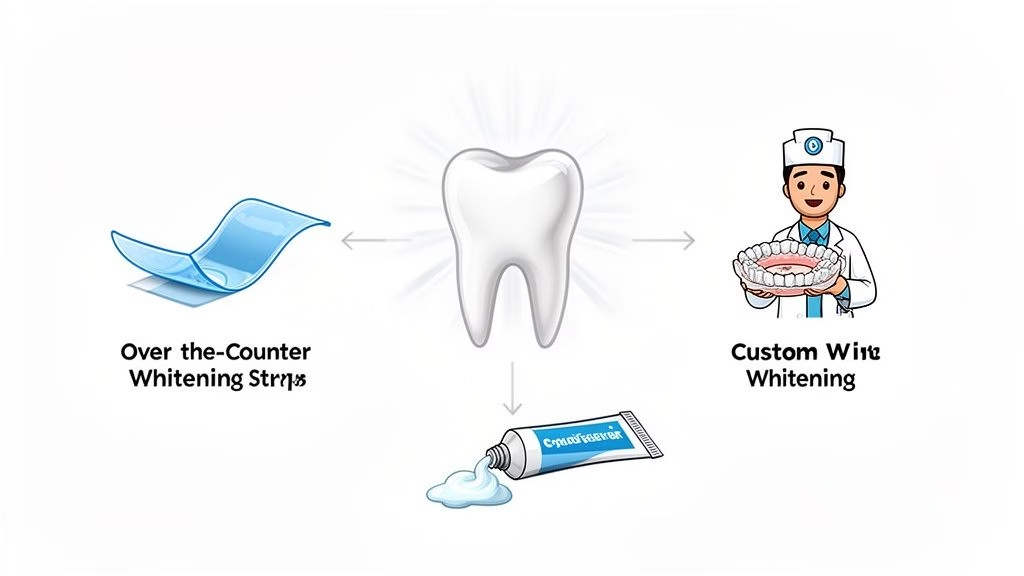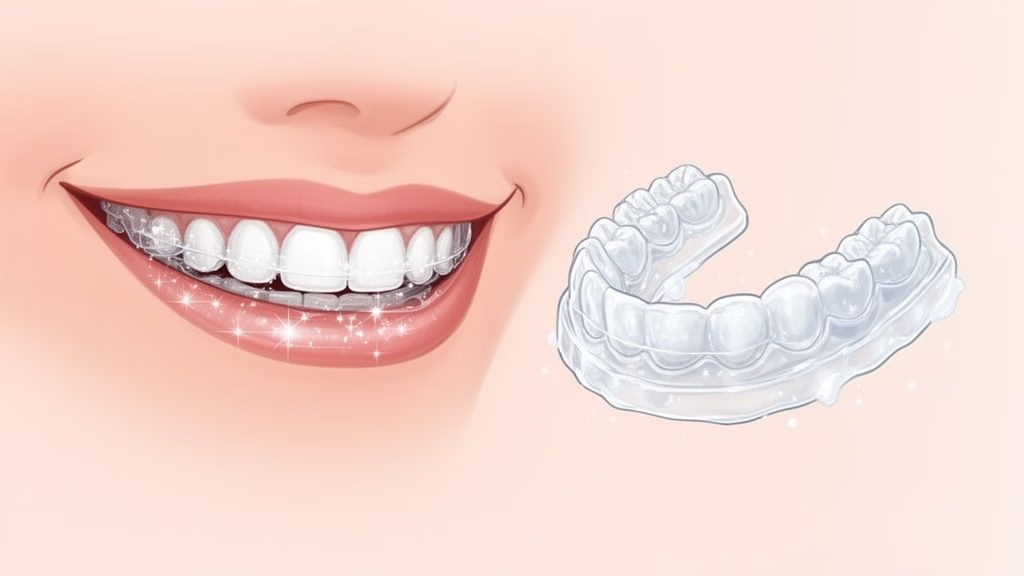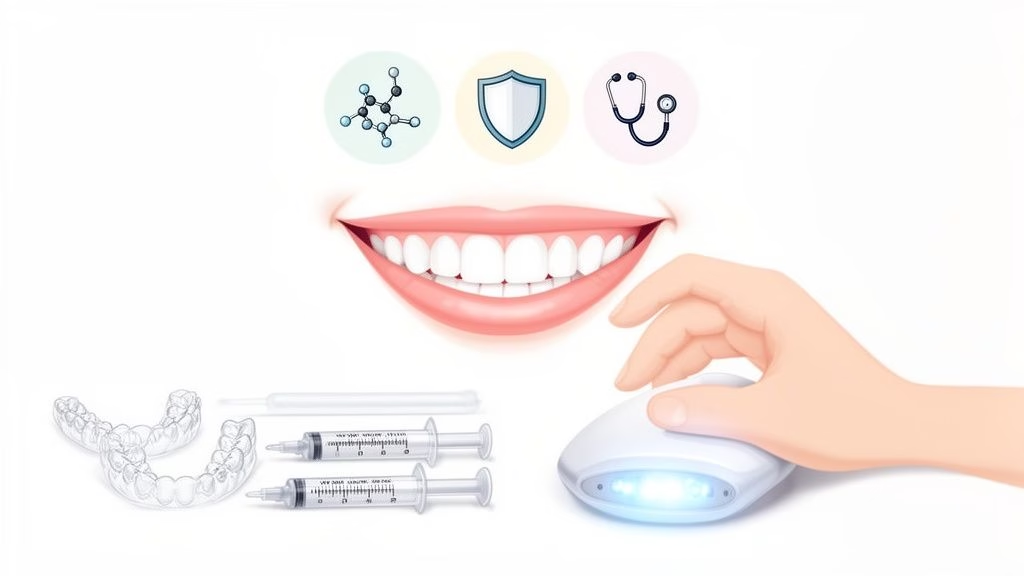Teeth Straightening at Home UK Your Complete Guide
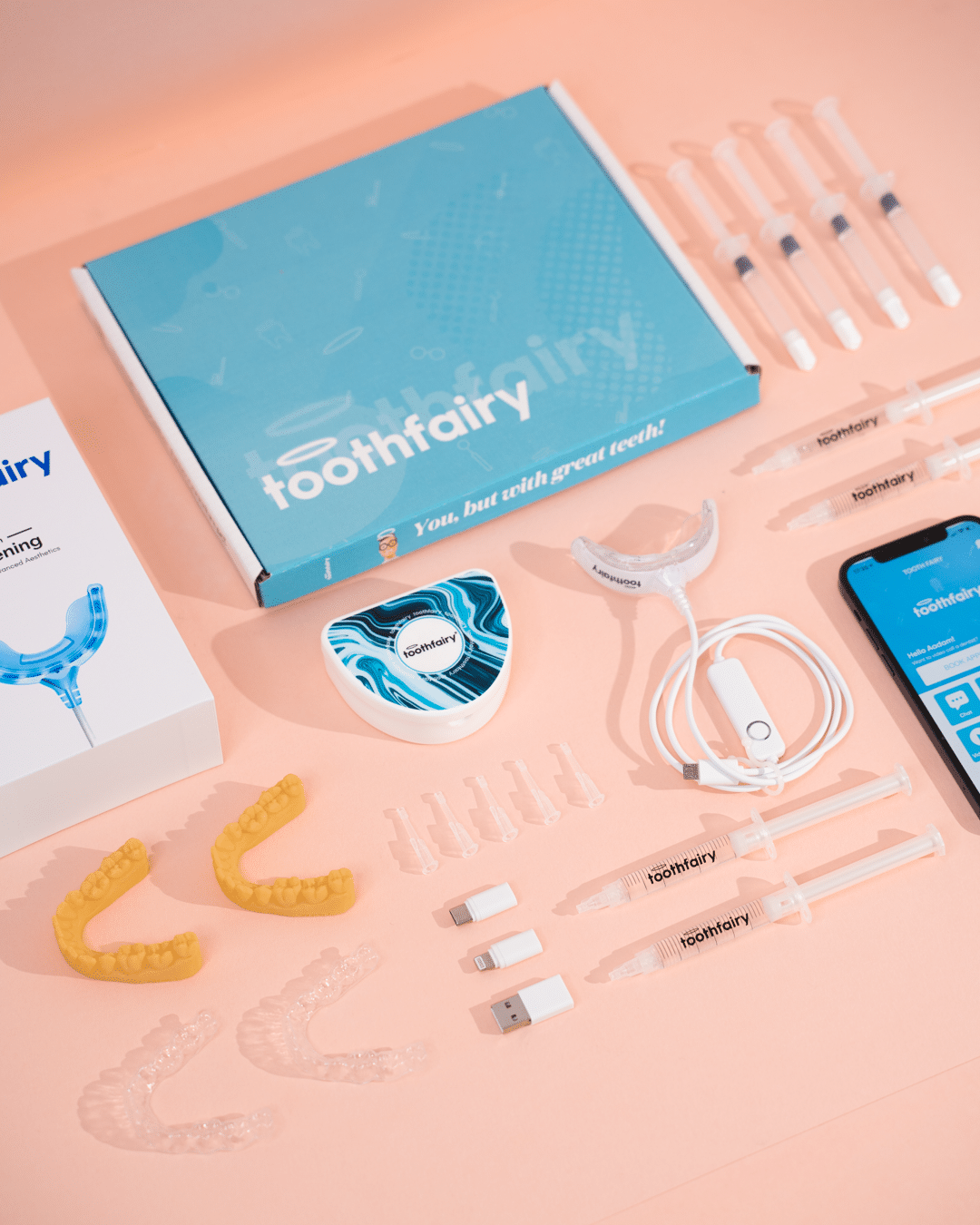
Ever wondered if you could get a straighter smile without trekking to the dentist every few weeks? The answer is a definite yes. Thanks to some big advances in teledentistry, teeth straightening at home in the UK has gone from a pipedream to a genuinely popular and practical option. This guide will walk you through how modern clear aligners provide a subtle, convenient alternative to old-school metal braces.
A More Convenient Way to Straighten Your Teeth in the UK
The desire for a better smile is nothing new, but the thought of metal wires, endless appointments, and eye-watering costs has always put people off. For a long time, your only real choices were traditional braces or pricey, in-clinic aligner brands, both demanding a huge investment of time and money. It left a lot of us in the UK feeling like a great smile was simply out of our league.
Thankfully, that’s all changing. The rise of teledentistry means you can now handle your entire teeth-straightening journey from your living room, without compromising on professional quality or safety. It’s a modern approach that fits around your life, not the other way around. With smarter and more affordable options like Toothfairy, professional cosmetic dental work is now more accessible than ever.
Blending At-Home Ease with Expert Oversight
The secret to successful teeth straightening at home in the UK is finding a system that perfectly balances convenience with professional supervision. Companies like Toothfairy are leading the charge here, offering a sensible and affordable route to the smile you want. The whole idea is to connect you with UK-registered dentists who create and oversee your treatment plan from a distance.
This isn’t some risky DIY project; it’s a professionally guided process from start to finish. You get to skip the hassle of constant clinic visits, but a qualified expert is still making sure the treatment is right for you. It all comes down to a few core benefits:
- Affordability: Cutting out the overheads of regular face-to-face appointments brings the cost down significantly, making a straighter smile accessible to more people.
- Convenience: The whole system is built for a busy life. You take your initial impressions at home and the aligners are delivered right to your door.
- Discretion: Clear aligners are practically invisible, so you can get on with straightening your teeth without feeling self-conscious.
- Expert Supervision: Every single treatment plan is designed and monitored by a qualified UK dentist. This gives you peace of mind that your dental health is in safe hands.
The real game-changer isn’t just the at-home model itself. It’s the smart combination of professional dental expertise with technology that’s actually easy to use. This is what guarantees your treatment is both safe and effective, giving you results you can count on without the old hassles.
Ultimately, this approach puts you in control. It uses technology to deliver a personalised, high-quality dental experience that’s both efficient and budget-friendly. It proves you no longer have to choose between getting professional care and having a convenient experience. You really can get the smile you’ve always wanted, on your own terms.
Is At-Home Teeth Straightening Right for You?
The thought of getting a straighter smile without endless trips to the dentist is a tempting one. But before you jump in, it’s crucial to figure out if this modern approach actually fits your specific dental needs. At-home clear aligners can be fantastic for fixing mild to moderate alignment issues – think small gaps, a bit of crowding, or teeth that are just a little out of line.
It’s about being realistic, though. For more complex problems like a severe overbite, majorly rotated teeth, or significant crowding, you’ll likely need the closer supervision and specialised techniques that only an in-person orthodontist can offer. Getting this distinction right from the start is the first real step towards a successful and safe treatment.
The Non-Negotiable Need for a Professional Assessment
This brings us to what is, without a doubt, the most important part of the entire process: a professional evaluation. Kicking off any kind of teeth-straightening treatment without getting the go-ahead from a dentist is a massive gamble. Hidden problems like gum disease, cavities, or weak tooth roots can be made much worse by the pressure from aligners, potentially leading to serious complications down the line.
This is exactly why a properly supervised model for teeth straightening at home in the UK is so important. With a service like Toothfairy, your journey doesn’t start with a kit arriving in the post. It begins with a professional digital assessment carried out by a UK-registered dentist, designed to thoroughly check your oral health and confirm you’re a good fit for remote treatment. This same platform can be used for dental emergencies or other cosmetic work, making professional care truly convenient.
This professional gatekeeping is what separates safe, effective teledentistry from risky, unsupervised DIY kits. It ensures your treatment plan is built on a solid foundation of good dental health, protecting you from potential harm and setting you up for the best possible results.
Identifying the Ideal Candidate for At-Home Aligners
So, what does a good candidate for at-home aligners usually look like? Every mouth is different, of course, but here are a few classic scenarios where they work brilliantly:
- Minor Gaps: You’ve got small but noticeable spaces between your front teeth you’d like to close.
- Slight Crowding: Your teeth overlap just enough to look a bit uneven or make flossing a chore.
- Previous Orthodontic Relapse: You wore braces years ago, but your teeth have sneakily shifted back a little.
- Cosmetic Tweaks: Your bite is generally fine, but you want to make some aesthetic improvements to your smile.
On the other hand, if you’re dealing with things like impacted teeth, severe crossbites, or the need for tooth extractions, an in-clinic aligner brand or traditional braces is going to be the right path for you.
Safety First: Understanding the UK Context
In the UK, there’s a lot of discussion around the safety of at-home teeth straightening, particularly when there isn’t enough dental supervision. While the low cost and convenience are a big draw, some online-only kits let you bypass a proper dental check-up. This can be genuinely risky if you have underlying issues.
UK dental experts are clear on this: a pre-treatment health assessment by a qualified dentist is essential to make sure you’re a suitable candidate and to avoid causing any harm.
As technology becomes more integrated into healthcare, having secure and reliable virtual platforms is key. For more on this, check out this complete guide to video conferencing for healthcare. It really drives home why a professionally managed process is so vital, ensuring your remote consultations are both secure and clinically robust, all while meeting the high standards of UK dental care. This is what makes sure your journey towards teeth straightening at home in the UK is not just easy, but genuinely safe.
How the At-Home Aligner Process Actually Works
So, how does straightening your teeth from your sofa actually happen? It might seem a bit like magic, but the process is surprisingly straightforward. Let’s pull back the curtain and walk through the entire journey, from that first online quiz to seeing your new smile in the mirror.
The whole system is built on smart tech and, crucially, professional dental oversight. It’s designed to make teeth straightening at home in the UK a safe and simple experience.
Your First Step: The Online Check-Up
It all kicks off with an online assessment. This isn’t just a tick-box exercise; it’s a vital first hurdle where a qualified UK dentist looks over your case. You’ll upload a few photos of your teeth from different angles and answer some questions about your dental health and what you’re hoping to achieve.
This initial check is all about making sure at-home aligners are the right and safe choice for you. Your dental health is the absolute priority from day one.
Getting a Perfect Model of Your Teeth
Once you get the go-ahead, the next job is to get a super-accurate model of your teeth. The classic way to do this is with an at-home impression kit. It sounds a bit technical, but it’s really not. The kit arrives with dental putty and trays, plus clear instructions to guide you through taking moulds of your top and bottom teeth.
This part is really important because these impressions are scanned to create a precise 3D digital model of your smile. It’s this digital twin of your teeth that the dental experts use to plan everything out. With a provider like Toothfairy, you’ll even get a 3D video preview showing exactly how your smile will change. It’s a fantastic way to see the final result before you even say yes.
This is a great visual of how simple the process flow really is.

As you can see, it’s all designed for convenience—starting online and ending with your custom aligners landing on your doorstep.
Living with Your Aligners
After you’ve seen the plan and given it the thumbs-up, your custom-made clear aligners are produced and sent directly to you. They arrive in a series, each set numbered in the order you’ll wear them. You’ll typically wear each aligner for about one to two weeks before switching to the next one in the sequence.
Every new aligner is a tiny bit different from the last, applying just the right amount of gentle, consistent pressure to nudge your teeth into place. This slow-and-steady approach is what makes it both comfortable and effective.
The main commitment from you? You need to wear them for about 22 hours a day. They only come out for eating, drinking anything that isn’t plain water, and for brushing and flossing.
Keeping an Eye on Your Progress
A question I get asked all the time is, “How does the dentist know my teeth are moving correctly if I’m not seeing them?” That’s where remote monitoring comes in. Using an app, you’ll send regular photos of your teeth.
Your assigned UK dentist reviews these progress pics to make sure everything is on track and moving as it should. This virtual supervision is the secret sauce. It gives you the best of both worlds: the ease of doing it all from home, but with the peace of mind that a professional is keeping a close eye on your treatment.
Hitting Your Smile Goal
So, how long does it all take? It’s different for everyone, of course, but for most people with mild to moderate issues, the whole journey takes between 4 and 9 months. That’s often a lot quicker than traditional metal braces.
The key to finishing on time is consistency. Hitting that 22-hour daily wear target and swapping your aligners on the right day is what will get you to the finish line with the best possible result.
Once you’ve worn your final aligner, the hard work is done! But there’s one last, crucial step: retention. You’ll need to wear a retainer to make sure your teeth stay put in their new, straighter positions for good.
Breaking Down the Cost of At-Home Aligners
Let’s be honest, the price tag is a huge deal when you’re thinking about any kind of dental work. For years, the high cost of traditional braces put a straighter smile out of reach for so many people. This is exactly where the idea of teeth straightening at home in the UK changes the game, offering a much more wallet-friendly path.
When you look at the numbers, the difference is stark. In-clinic aligner brands often start at £2,500 and can easily climb to over £5,000. Why so much? A lot of that cost comes from the overheads of running a physical clinic—you’re paying for the dentist’s time during multiple appointments, the fancy office, and the premium brand name.
At-home solutions cut out a lot of that fat. By handling the initial impressions yourself and having remote check-ins with a dentist, the whole process becomes far more efficient. Those savings are passed directly on to you.
What Is Included in the Price?
So, what are you actually getting for your money? When you sign up for an at-home aligner system, you’re not just buying a box of plastic trays. You’re paying for the entire journey, from the first impression to the final retainer.
This all-in-one approach is great because it means no nasty surprise bills down the line. Here’s a typical rundown of what’s covered in the price:
- The Impression Kit: Everything you need to take an accurate mould of your teeth right from your living room.
- Your Full Set of Aligners: Every single custom-made aligner required to move your teeth from where they are now to their final, straighter position.
- Professional Oversight: A UK-registered dentist designs your personal treatment plan and keeps an eye on your progress remotely. This is the most crucial part.
- Post-Treatment Retainers: To make sure your teeth don’t start shifting back, your first set of retainers is almost always included in the package.
This bundled pricing gives you peace of mind, knowing the total cost upfront.
The real cost difference boils down to efficiency. At-home systems use technology for remote monitoring, which is simply a smarter, more cost-effective way to handle routine check-ups than booking out a dentist’s chair every few weeks.
An Affordable Path with Toothfairy
At Toothfairy, our whole philosophy is about delivering incredible value without ever cutting corners on care. We’re firm believers that professional dental oversight is essential, but it shouldn’t cost the earth. That’s why our pricing is designed to be one of the most straightforward and affordable options for dentist-led teeth straightening at home in the UK.
We also know that even a lower price can be a big number to pay all at once. That’s where our flexible payment plans come in. Spreading the cost into manageable monthly payments makes a confident new smile a realistic goal, not a far-off dream. You can get started right away without needing to save for years.
When comparing options, it helps to see the figures side-by-side.
Cost Comparison: At-Home vs In-Clinic Aligners
This table breaks down the typical costs and what you get with a remote system like Toothfairy versus a traditional in-clinic aligner brand.
| Feature | At-Home Aligners (e.g., Toothfairy) | In-Clinic Aligner Brands |
|---|---|---|
| Typical Cost | £1,399 – £1,800 | £2,500 – £5,000+ |
| Appointments | Remote monitoring by a UK dentist | Multiple in-person clinic visits |
| Impression Method | At-home kit (sometimes with scan options) | In-clinic 3D scan |
| What’s Included | Impression kit, all aligners, retainers | Aligners (retainers often cost extra) |
| Convenience | Managed entirely from home | Requires travel & time off for appointments |
Ultimately, choosing a more affordable at-home aligner doesn’t mean you’re settling for less. It means you’re opting for a more modern, efficient service that fits into your life and budget. You still get high-quality, custom aligners and professional dental supervision—it’s just delivered in a much smarter way.
Practical Tips for a Successful Aligner Journey
Starting your journey to a straighter smile is exciting, but it’s your commitment that truly turns that excitement into fantastic results. When it comes to teeth straightening at home in the UK, getting the best outcome really boils down to a few simple, consistent habits. These are the real-world tips that make sure your treatment is smooth, comfortable, and ultimately, a massive success.
Think of it this way: your dentist designs the roadmap, but you’re in the driver’s seat. Sticking to the plan is everything. This means getting your daily routine down pat, from keeping your aligners pristine to wearing them for the full recommended time.

Master Your Oral Hygiene Routine
Good oral hygiene is always important, but it becomes non-negotiable when you’re wearing aligners. Because the trays cover your teeth for most of the day, they can easily trap food particles and bacteria. If you’re not careful, this can increase your risk of cavities and gum irritation.
The golden rule is simple: never put your aligners back in without cleaning your teeth first. After every single meal or snack, you’ll need to brush and floss thoroughly. This simple step prevents plaque from building up under the aligner and is key to keeping your teeth and gums healthy throughout the process.
A great tip is to put together a little “aligner kit” to carry with you. A travel toothbrush, a mini tube of toothpaste, and some floss will mean you’re always prepared, whether you’re at work or out for dinner with friends.
Keeping Your Aligners Clean and Clear
Just as you need to clean your teeth, you have to clean your aligners too. Plaque and bacteria can build up on them just as easily, which can lead to discolouration and bad breath. A quick daily cleaning routine is all it takes to keep them fresh and virtually invisible.
Here are a few easy ways to keep them in top condition:
- Gentle Brushing: Use a soft-bristled toothbrush and a tiny amount of clear, unscented soap or washing-up liquid. Gently brush your aligners, but avoid using regular toothpaste – its abrasive ingredients can scratch the plastic.
- Denture or Retainer Tablets: Popping your aligners into a specialised cleaning solution for a few minutes each day is a brilliant way to kill bacteria and get rid of any stubborn buildup.
- Rinse Thoroughly: Always rinse your aligners with cool or lukewarm water after cleaning. Never, ever use hot water, as it can warp the delicate plastic and ruin their precise fit.
Embrace the Pressure and Stick to the Schedule
When you pop in a new set of aligners, you’ll probably feel some pressure or tightness for the first day or two. Don’t worry, this is actually a good sign! It tells you the aligner is working as intended, applying that gentle force needed to guide your teeth into their new positions.
Any discomfort is usually mild and can be managed with over-the-counter pain relief if you need it. The sensation typically fades quickly as your teeth get used to the new tray.
The single most critical factor for success is wear time. You absolutely must wear your aligners for at least 22 hours per day. Falling short of this can slow your progress right down and even compromise your final results, as teeth can start to shift back if the aligners are out for too long.
This is where a service like Toothfairy really shines. Our dedicated app helps you track your wear time and sends reminders to keep you on schedule. Plus, if you have any questions or concerns, you can connect with our dental team right away for guidance. It’s this blend of personal responsibility and professional backup that makes the experience so much smarter and more manageable.
The All-Important Role of Retainers
So, you’ve finished your last set of aligners and are admiring your new smile. The journey isn’t quite over yet. Now comes the final—and arguably most important—phase: retention. Teeth have a natural memory and a tendency to want to drift back to their original positions. This is a process known as relapse.
To stop this from happening and protect your investment, you’ll need to wear a retainer. At first, you’ll probably wear it full-time (just like your aligners), before gradually moving to wearing it only at night. Your dentist will give you a specific schedule that’s tailored for you.
Think of your retainers as the insurance policy for your smile. Wearing them consistently is what ensures the beautiful results you’ve worked so hard for will last a lifetime. Neglecting this final step is one of the most common reasons for orthodontic relapse, so it’s vital to make it a permanent part of your nightly routine.
Got Questions About Straightening Your Teeth at Home?
Deciding to straighten your teeth from home is a big step, so it’s completely natural to have a few questions buzzing around your head. You want to know exactly what you’re signing up for, and rightly so.
Let’s walk through some of the most common queries I hear, covering everything from the timeline to what the process actually feels like and, crucially, what happens once you’re done.
How Long is This Going to Take?
This is usually the first thing people ask, and the honest answer is: it really depends on your individual smile. But here’s the good news—one of the biggest draws of at-home aligners is just how efficient they can be for the right person.
If you’re dealing with mild to moderate issues, like small gaps or a bit of crowding, you could be looking at a total treatment time of just 4 to 9 months. That’s a world away from traditional train tracks or even some in-clinic aligner systems, which can often take 18 months or even longer. The treatment is laser-focused on making those cosmetic adjustments that make the biggest difference to your smile.
Of course, you won’t be guessing. A UK-registered dentist will map out your exact timeline from the get-go. With a service like Toothfairy, you get a 3D preview showing not just your final smile, but also a precise estimate of how long it’ll take to get there—all before you part with a penny.
Will it Hurt?
Let’s be honest, orthodontics has a bit of a reputation for being painful, mostly thanks to memories of tightened metal braces. Clear aligners are a whole different ball game. While I wouldn’t say it’s completely sensation-free, most people find it far more comfortable.
You should expect a bit of pressure or mild tenderness for the first day or so after popping in a new set of aligners. That’s actually a good sign! It’s the feeling of your teeth being gently nudged into their new, straighter positions.
Think of it less as “pain” and more as a dull ache. It’s temporary and usually subsides within 24-48 hours as your teeth get used to the new aligner. Most people find it easy to manage without reaching for painkillers.
This gentle, consistent pressure is precisely what makes modern aligners so effective. The whole system is designed to be as comfortable as possible while still delivering brilliant results.
What Happens When I’m Finished?
So, you’ve reached the end of your last aligner set and your smile is looking fantastic. Congratulations! But don’t put your feet up just yet. There’s one final, absolutely critical step to keeping it that way: retention. Teeth have a pesky habit of trying to wander back to where they started.
To lock in your new smile and protect your investment, you’ll need to wear a retainer.
- At First: You’ll wear your retainer full-time (about 22 hours a day) for the first few weeks, just like you did with your aligners. This gives your teeth time to properly settle into their new spots.
- Then: After that initial period, your dentist will almost always give you the green light to switch to wearing them only at night.
- For Life: This nightly routine is your insurance policy for a permanently straight smile. It’s a simple habit that ensures all your hard work pays off for decades.
Your first set of custom-made retainers is usually included in your package. It’s the non-negotiable final step that ensures your new smile stays exactly where it should.
Ready to see if there’s a smarter, more affordable way to get the smile you want, with a dentist guiding you every step of the way? Find out if you’re a candidate with Toothfairy.
Learn more and get started on the Toothfairy website
Last updated on September 8, 2025

Toothfairy Care Team
Toothfairy, is the world's smartest dental app, that connects patients to a dentist for a range of issues, from emergencies, cosmetics, prescriptions to virtual exams.
Toothfairy Care Team
Toothfairy, is the world's smartest dental app, that connects patients to a dentist for a range of issues, from emergencies, cosmetics, prescriptions to virtual exams.

